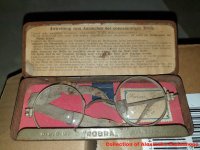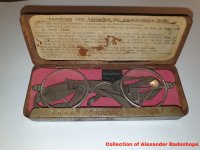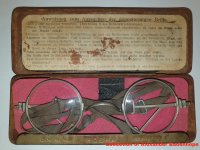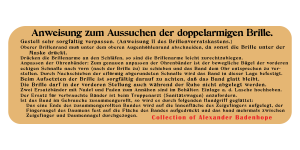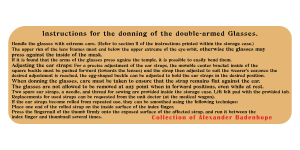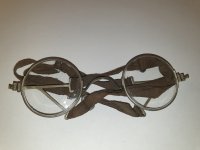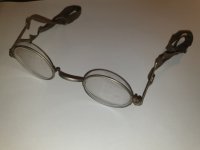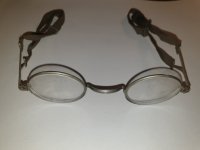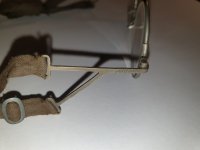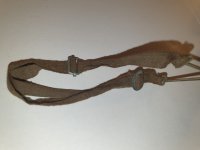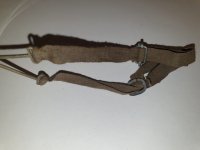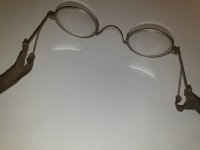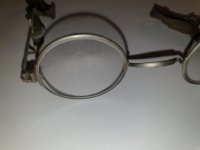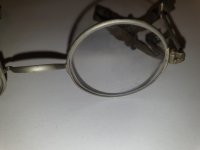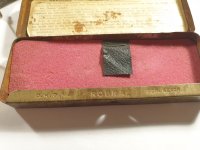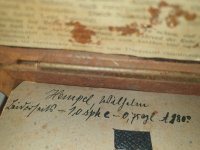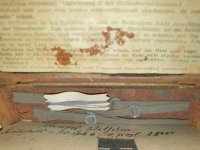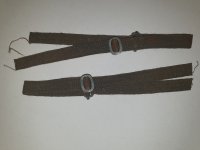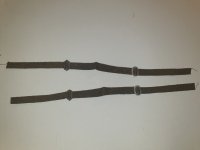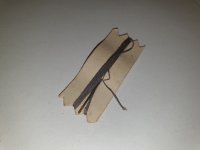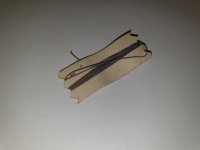Hello again Everyone,
Today I present to you all a piece of kit that I've been hunting for quite some time.
Ever since I re-established my World War 1 German gas mask collection, I've been looking for an appropriate set of these eyeglasses to compliment my masks. Finally, after a couple years of waiting around (and the desperate purchase of a destroyed pair a few months before coming across my complete set) I have in my collection a wonderful example of German "Maskenbrille" (Mask Glasses), complete in their original carry case.
Lets start off with my first and, sadly, damaged example:

As you all can see, this pair is sadly missing its right arm and strap. Of course, all of its accessories are also unfortunately missing. This set actually cost me more than my second, intact set. Funny how that works sometimes. The only saving grace with this example is that it is named and carries the wearer's prescription details on a sticker attached to the cardboard-backed felt divider. It is my theory (based solely on my own lunacy) that this soldier absolutely wore out this particular set, and was issued another pair at some point, and he began pillaging his old set for spare parts. I hypothesize this because on the right side, with the missing arm and strap, the hinge which the arm would have pivoted on, and the miniscule screw which holds the lens in and the arm in place, are completely intact still, and undamaged. This means the arm was not ripped out forcefully; but, carefully removed. The patina is such that this had to have been done many years ago, and was not done recently, leading me to believe that this example was either parted out by the soldier himself, or perhaps, returned to the unit's doctor and used by him as a source of spares for still-in-service sets. Though, the idea of them being returned to the unit doctor seems a little far-fetched, as I believe that he would have simply removed the lenses and placed them in new frames for the soldier. Prescription lenses weren't that easy to come by in war torn, heavily rationed, early 20th century, Europe. In fact, a shortage of optics of all kinds was behind the British-German plan to trade British rubber for German optics. The situation was not much better for Germany, and by the end of the war they had also outstripped their production capacity for optics themselves, while the British had since corrected their deficit to the point that they no longer needed to consider trading with the Germans for them.
That'ss all we will be seeing of this example as, thankfully, I have the immense honor of presenting a fully intact set which is a far better specimen for examination.
I will start at the beginning with the carry case.
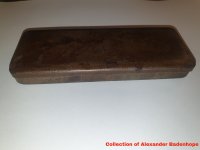
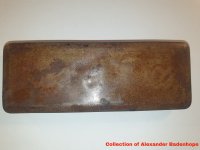
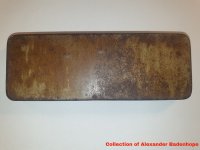
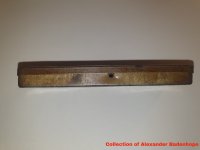
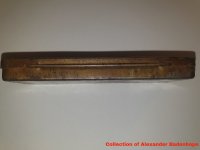
As one might notice, these World War 1 Maskenbrillen were provided inside a case which is very similar to that of the later World War 2 era Maskenbrillen issued by the Germans, the largest apparent difference is the lack of paint on the cases, instead, a thin lacquer was applied to the metal in order to prevent rusting (not unlike the finish found on many pieces of Japanese equipment from the Second World War). On my damaged set pictured above, the lacquer has worn entirely away and permitted rusting; however, the lacquer on this example is intact and is still doing an excellent job preserving the metal, even after more than 100 years. There were a few different patterns of this carrier issued, all of them essentially identical.
The major difference I've spotted so far are:
1. Difference in felt color
2. Difference in rivet location
3. Variations in instruction
4. Case stampings
An explanation of the above-mentioned variations:
1. Some sets I have encountered have felt in various shades of a deep blue, others are various shades of red, it's possible other colors may exist as well.
2. Similarly, the rivet which holds the felt, cardboard-backed insert is encountered both mounted on the front of the box (enabling the flap to be opened towards the front of the box) or on the left of the box (allowing the flap to be pulled open sideways).
3. The instructions are also encountered with some variation, even between my two examples (which seem to come from the same subcontractor) are very slightly different.
4. Finally, some cases encountered online seem to be stamped on the bottom with some manufacturer details.
This all leads me to believe that these variations are related to the subcontractor and perhaps the date of production; however, no variation seems to have existed in the glasses themselves though. It's possible the glasses were all made at the same place, while the carry cases were subcontracted; however, this is, again, conjecture.
Speaking of date of production:
I have had a very difficult time dating these glasses. I have read some unsubstantiated claims on various sites which assert that they appeared around 1917. The most detailed of these claim that such glasses were not developed earlier because the warring powers were averted to sending men with vision defects to the front at the beginning of the war; however, as casualty numbers mounted and the supply of able men began to dwindle, those with vision defects could no longer be spared from service at the front, hence the need to develop proper glasses for masks. While I do not know enough about military history to substantiate nor refute this statement, I can't say that I'm a particularly big believer in it. I believe that a substantial number of the "Regulars" deployed by both sides at the start of the war were at least intermittent glasses wearers, there are plenty of photographs of officers and men wearing various forms of corrective lenses to substantiate that.
Gas use began around mid-1915 with a very primitive starting point. Masks were little more than soaked gauze pads and a set of goggles in the early months. The Germans didn't get the first versions of what would become what we know of today as the GM-15 into the field until around the end of 1915, and didn't finalize its design until 1916, with the GM-17 Ledermasken following close behind in 1917, and the GM-18 models a year later, with filter changes mixed in and all. It is also worth noting here that the GM-17 in particular had known sealing problems due to its leather construction and was developed, in part, as a response to the rubber shortage the Germans were experiencing, and it is very possible that these new masks with known sealing problems were the proverbial "straw that broke the camel's back" which forced the Germans to finally start issuing purpose-built glasses to help ease these problems.
All that is to say that I believe (again based only on my own conjecture) that the issue of masks sealing around eyeglasses was probably a known and researched problem from nearly the beginning of protective mask use during the war, a problem which only became more important to resolve as the war dragged on (and, in the case of the Germans, as mask construction changes caused sealing issues to be aggravated). If indeed these glasses only started making it to the front in 1917, it probably had little to do with the men themselves not being allowed to have vision defects. It could have very well taken until around 1917 for the first purpose-built glasses to be finalized and produced in great enough quantities to be issued en masse, given the fact that less than 2 years had gone by at that point since gas was first fielded (anyone who's done time in the military will tell you how long it takes for new things, even once publicly announced, to reach the men in the field). In addition, the earliest gases had poor lethality in comparison with later gasses and cocktails of toxins, requiring heavier exposure than later agents, meaning that small imperfections in the seal caused by eye-glasses arms were unlikely to expose the soldier to a significant enough amount of the toxins to affect him, especially as the majority of glasses in this era were wire frames. There was probably, at the beginning, simply not enough of a reason to fuss over what amounted to a niche problem in the eyes of the top brass. However, as gas use increased along with the lethality of the agents, it became obvious that a true solution was needed.
If anyone else has any concrete evidence regarding their original issue date, I would love to hear from you!
For now, that's enough of me talking out of my rump, let's finally get to the glasses!
POST CONTINUES BELOW
Today I present to you all a piece of kit that I've been hunting for quite some time.
Ever since I re-established my World War 1 German gas mask collection, I've been looking for an appropriate set of these eyeglasses to compliment my masks. Finally, after a couple years of waiting around (and the desperate purchase of a destroyed pair a few months before coming across my complete set) I have in my collection a wonderful example of German "Maskenbrille" (Mask Glasses), complete in their original carry case.
Lets start off with my first and, sadly, damaged example:
As you all can see, this pair is sadly missing its right arm and strap. Of course, all of its accessories are also unfortunately missing. This set actually cost me more than my second, intact set. Funny how that works sometimes. The only saving grace with this example is that it is named and carries the wearer's prescription details on a sticker attached to the cardboard-backed felt divider. It is my theory (based solely on my own lunacy) that this soldier absolutely wore out this particular set, and was issued another pair at some point, and he began pillaging his old set for spare parts. I hypothesize this because on the right side, with the missing arm and strap, the hinge which the arm would have pivoted on, and the miniscule screw which holds the lens in and the arm in place, are completely intact still, and undamaged. This means the arm was not ripped out forcefully; but, carefully removed. The patina is such that this had to have been done many years ago, and was not done recently, leading me to believe that this example was either parted out by the soldier himself, or perhaps, returned to the unit's doctor and used by him as a source of spares for still-in-service sets. Though, the idea of them being returned to the unit doctor seems a little far-fetched, as I believe that he would have simply removed the lenses and placed them in new frames for the soldier. Prescription lenses weren't that easy to come by in war torn, heavily rationed, early 20th century, Europe. In fact, a shortage of optics of all kinds was behind the British-German plan to trade British rubber for German optics. The situation was not much better for Germany, and by the end of the war they had also outstripped their production capacity for optics themselves, while the British had since corrected their deficit to the point that they no longer needed to consider trading with the Germans for them.
That'ss all we will be seeing of this example as, thankfully, I have the immense honor of presenting a fully intact set which is a far better specimen for examination.
I will start at the beginning with the carry case.





As one might notice, these World War 1 Maskenbrillen were provided inside a case which is very similar to that of the later World War 2 era Maskenbrillen issued by the Germans, the largest apparent difference is the lack of paint on the cases, instead, a thin lacquer was applied to the metal in order to prevent rusting (not unlike the finish found on many pieces of Japanese equipment from the Second World War). On my damaged set pictured above, the lacquer has worn entirely away and permitted rusting; however, the lacquer on this example is intact and is still doing an excellent job preserving the metal, even after more than 100 years. There were a few different patterns of this carrier issued, all of them essentially identical.
The major difference I've spotted so far are:
1. Difference in felt color
2. Difference in rivet location
3. Variations in instruction
4. Case stampings
An explanation of the above-mentioned variations:
1. Some sets I have encountered have felt in various shades of a deep blue, others are various shades of red, it's possible other colors may exist as well.
2. Similarly, the rivet which holds the felt, cardboard-backed insert is encountered both mounted on the front of the box (enabling the flap to be opened towards the front of the box) or on the left of the box (allowing the flap to be pulled open sideways).
3. The instructions are also encountered with some variation, even between my two examples (which seem to come from the same subcontractor) are very slightly different.
4. Finally, some cases encountered online seem to be stamped on the bottom with some manufacturer details.
This all leads me to believe that these variations are related to the subcontractor and perhaps the date of production; however, no variation seems to have existed in the glasses themselves though. It's possible the glasses were all made at the same place, while the carry cases were subcontracted; however, this is, again, conjecture.
Speaking of date of production:
I have had a very difficult time dating these glasses. I have read some unsubstantiated claims on various sites which assert that they appeared around 1917. The most detailed of these claim that such glasses were not developed earlier because the warring powers were averted to sending men with vision defects to the front at the beginning of the war; however, as casualty numbers mounted and the supply of able men began to dwindle, those with vision defects could no longer be spared from service at the front, hence the need to develop proper glasses for masks. While I do not know enough about military history to substantiate nor refute this statement, I can't say that I'm a particularly big believer in it. I believe that a substantial number of the "Regulars" deployed by both sides at the start of the war were at least intermittent glasses wearers, there are plenty of photographs of officers and men wearing various forms of corrective lenses to substantiate that.
Gas use began around mid-1915 with a very primitive starting point. Masks were little more than soaked gauze pads and a set of goggles in the early months. The Germans didn't get the first versions of what would become what we know of today as the GM-15 into the field until around the end of 1915, and didn't finalize its design until 1916, with the GM-17 Ledermasken following close behind in 1917, and the GM-18 models a year later, with filter changes mixed in and all. It is also worth noting here that the GM-17 in particular had known sealing problems due to its leather construction and was developed, in part, as a response to the rubber shortage the Germans were experiencing, and it is very possible that these new masks with known sealing problems were the proverbial "straw that broke the camel's back" which forced the Germans to finally start issuing purpose-built glasses to help ease these problems.
All that is to say that I believe (again based only on my own conjecture) that the issue of masks sealing around eyeglasses was probably a known and researched problem from nearly the beginning of protective mask use during the war, a problem which only became more important to resolve as the war dragged on (and, in the case of the Germans, as mask construction changes caused sealing issues to be aggravated). If indeed these glasses only started making it to the front in 1917, it probably had little to do with the men themselves not being allowed to have vision defects. It could have very well taken until around 1917 for the first purpose-built glasses to be finalized and produced in great enough quantities to be issued en masse, given the fact that less than 2 years had gone by at that point since gas was first fielded (anyone who's done time in the military will tell you how long it takes for new things, even once publicly announced, to reach the men in the field). In addition, the earliest gases had poor lethality in comparison with later gasses and cocktails of toxins, requiring heavier exposure than later agents, meaning that small imperfections in the seal caused by eye-glasses arms were unlikely to expose the soldier to a significant enough amount of the toxins to affect him, especially as the majority of glasses in this era were wire frames. There was probably, at the beginning, simply not enough of a reason to fuss over what amounted to a niche problem in the eyes of the top brass. However, as gas use increased along with the lethality of the agents, it became obvious that a true solution was needed.
If anyone else has any concrete evidence regarding their original issue date, I would love to hear from you!
For now, that's enough of me talking out of my rump, let's finally get to the glasses!
POST CONTINUES BELOW

